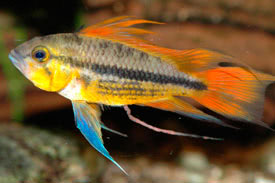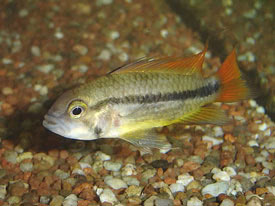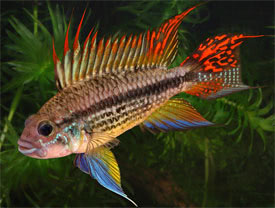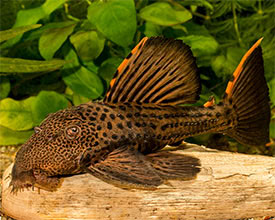
 Magyarul / Hungarian
Magyarul / Hungarian


- Scientific name: Apistogramma cacatuoides
- Common name: Cockatoo dwarf cichlid, Crested dwarf cichlid
- Group: Cichlids
- Habitat: South America, between 69th and 71st parallels W. in the Amazon basin
- Size: Male:8 cm, female: 5 cm.
- Biotope: Shallow, still to slow-moving waters, with leaf litter as a substrate.
- Social behavior: Territorial and polygamous, you should allow five or six females for each male.
- Diet: Carnivorous, all types of live foods, such as water fleas, cyclops, mosquito larvae and tubifex worms.
- Breeding: Quite easy
- Tank: Minimum 60 litres.
- Population: 1 male and 2-3 fameles for 90 litres
- Decoration: Need a tank with fine, dark sand. Build a breeding cave of rocks or a pot, near the center of each female's territory.
- Temperature: 24-26°C
- pH: 6-8
- Hardness: 1-15 NK°
- Lifespan: 5 years
Description: Males have highly developed fins. The dorsal fin's first three to five rays are elongated and stand out among the others. Various color morphs can be found. The most common variety has a brown to gray body coloring. The belly is golden-brown as well as the anal, pelvic, and dorsal fins. The anal fin is edged with a blue-green fringe, as are the pelvic fins. The pointed dorsal rays are tipped with orange, that become green before reaching the main part of the fin, which is gold. The body is marked with one lateral stripe that extends from the eye to the caudal fin. Below this stripe are three shorter lines. The species is sensitive to water and medication. Do not treat eggs for fungus.
Sexual dimorphism: male is substantially larger, has longer fins and lacks a forked caudal fin. While caring for the brood, the female may be bright yellow. Male will claim the upper area of the tank, while the females select smaller breeding territories near the bottom.
For breeding recommend neutral, soft to medium-hard water (pH about 7, hardness to 10 °dGh) at a temperature between 25-27 °C. Cave breeders, the female lay as many as 80 eggs against the roof. The female guards the eggs and brood, the male guards the entire territory. The eggs hatch after three to four days. Start feeding them with roftiers. Fry will often change mothers as they grow.

























































